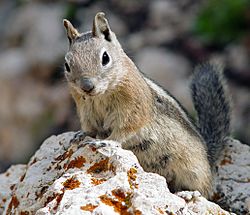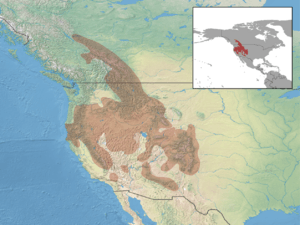Golden-mantled ground squirrel facts for kids
Quick facts for kids Golden-mantled ground squirrel |
|
|---|---|
 |
|
| Conservation status | |
| Scientific classification | |
| Kingdom: | |
| Phylum: | |
| Class: | |
| Order: | |
| Family: | |
| Genus: |
Callospermophilus
|
| Species: |
C. lateralis
|
| Binomial name | |
| Callospermophilus lateralis (Say, 1823)
|
|
 |
|
| Synonyms | |
|
Spermophilus lateralis |
|
The golden-mantled ground squirrel (Callospermophilus lateralis) is a type of ground squirrel. It lives in western North America. You can find it from British Columbia and Alberta in Canada, all the way down through the western United States to California, Arizona, and New Mexico.
Contents
About the Golden-Mantled Ground Squirrel
This ground squirrel is usually about 23 to 29 centimeters (9 to 11 inches) long. Adults weigh between 120 and 394 grams (about 0.26 to 0.86 pounds). Its belly is whitish or yellow-gray. The tail is brown to black with yellowish-red on the underside. It has light rings around its eyes.
A special feature is the "mantle" across its shoulders, which is a reddish-brown color. Males often have a deeper red color. You can tell this squirrel apart from others by a white stripe bordered with black that runs down each side of its back.
Where They Live and What They Eat

Their Home Environment
These squirrels live in different places like forests, chaparral (a type of shrubland), and areas near meadows. They also like places with lots of rocks or fallen leaves and branches, which give them shelter. They are often found near many kinds of pine trees, aspen trees, and manzanita bushes.
What They Eat
The golden-mantled ground squirrel is an omnivore. This means it eats both plants and animals. Their diet includes pine nuts, acorns, herbs, shrubs, and fungi. They also enjoy many kinds of insects, eggs, young birds, lizards, and even dead animals. If people are around, they might also eat human food. These squirrels often store food near their burrows, especially in late summer and fall. They have even been known to "beg" for food from people in areas where wildlife and cities meet.
Life Cycle and Behavior
Hibernation and Reproduction
These squirrels hibernate during the winter months. To get ready, they gain extra weight in the summer. They hibernate in dens that can be very long, sometimes up to 30 meters (100 feet), but they are usually not very deep.
The breeding season starts in the spring when males and females wake up from hibernation. Most baby squirrels are born in July. A female usually has two to eight young in a litter, with five being the average. The father does not help raise the babies. Young squirrels look like adults by about 40 days old. These ground squirrels can live for up to seven years.
How They Interact
Most adult squirrels live on their own. They usually compete for food and other things, rather than working together. However, they might gather in places where there is a lot of food, but they still have a pecking order. Adults live alone in their burrows. They build nests inside for hibernating or raising their young. Sometimes, they even make nests in buildings, like under roofs!
These squirrels can make squeaking noises or growl when they feel threatened. But generally, they are not very noisy animals.
Who Hunts Them
Snakes, foxes, weasels, and bears are some of the animals that hunt these squirrels. Golden-mantled ground squirrels can sometimes carry a tiny bug called the Rocky Mountain wood tick. This tick can spread certain sicknesses, like Rocky Mountain spotted fever.
Conservation Status
The golden-mantled ground squirrel is a common animal and can be found in many places. Because of this, it is not considered to be an endangered or threatened species.
Images for kids
-
A golden-mantled ground squirrel near Lake Almanor, California
See also
 In Spanish: Ardilla de manto dorado para niños
In Spanish: Ardilla de manto dorado para niños



